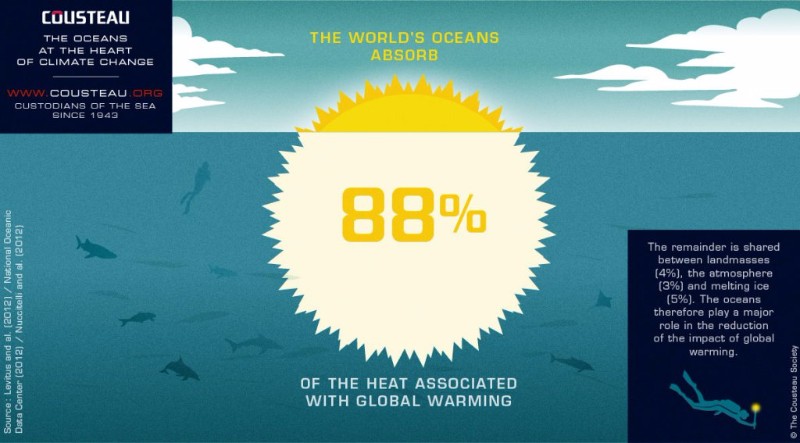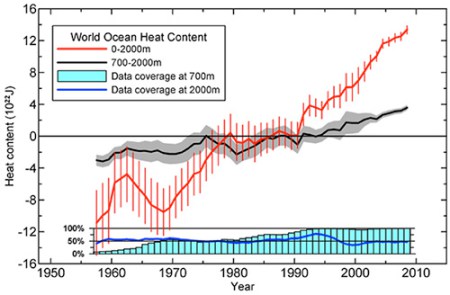The oceans at the heart of climate change
On the occasion of the 2015 Paris Climate Change Conference, The Cousteau Society will provide you with keys to understance the importance of ocean in climate change. Data visualisations will be available regulary on our website. This month, discover the crucial role of oceans in regulating the excess heat induced by greenhouse gases.
The world’s oceans absorb heat
For any given rise in temperature, the world’s oceans store ten times more heat that the atmosphere. Taking into account the oceans’ considerable volume (300 times that of the atmosphere) the oceans trap more thermal energy that any other part of the planet. If the heat stored was released into the atmosphere, global temperatures would rise by 18 °C. The ocean acts as a thermal buffer. This capacity delays CO2 induced global warming by as much as one or two decades.
An uneven distribution of heat
Two thirds of the heat absorbed by the oceans is distributed within the first 700 meters of depth. Within the first 75m, the temperature has risen by 0.11°C per decade between 1971 and 2010. Although this may appear to be only a slight variation, it actually has significant consequences regarding ocean circulation and sea level. Indeed, one of the key mechanisms underlying the formation of sea currents is related to the water’s temperature and salinity, which induce different densities. Cool and salty water masses tend to sink under the warmer ones, a phenomenon called « thermohaline circulation », which could be altered as a consequence of the oceans’ heat absorbtion. The warming of the first thousand meters of the ocean accounts for about 25% of the sea level rise of the past 50 years (0.4 to 1.8 mm / year observed). Marine biodiveristy is also threatened, as some species are particularly affected by temperature variations. Some populations of fish have already migrated away from their natural habitats, with significant economic consequences for fisheries, such as herring, cod and certain shrimp, which are moving further towards the Polar Regions.
Below a depth of 700m, heat diffusion is difficult to monitor. Temperature measurements can’t be done in a regular manner and unlike at the surface, cannot make use of satellites. The deeper layers are affected in a heterogeneous way: warm water masses can be transported to greater depths in different regions by currents, reinforcing this disparity. Below this depth, no indication of warming has been observed, neither between 2000 and 3000m nor in the abyssal ocean (below 3000m).
World ocean heat content and thermosteric sea level change (0–2000 m), 1955–2010
Source :
Geophysical Research Letters
Volume 39, Issue 10, L10603, 17 MAY 2012 DOI: 10.1029/2012GL051106
http://onlinelibrary.wiley.com/doi/10.1029/2012GL051106/full#grl29030-fig-0001
A strengthening of the thermocline
There’s naturally a marked difference in temperature between the oceans’ surface water and the greater depths. This thin layer of rapid transition is called the “thermocline”, and its depth varies depending on the season, the sea and the region. The extra heat absorbed results in an intensification of this difference, which has seen an increase of 4% from 1971 to 2010. This change can disrupt the process by which cold water upsurges provide an important source of nutrients, which is crucial to the richness of marine coastal ecosystems all over the world. Many biological processes will be affected by the modification of this thermal boundary: one example which is fundamental in the food chain is the daily vertical migration of plankton, which may be affected by changes in thermocline.
Can warm water rise back up from the deep ocean?
After having reached a heat record in 1998 following an El Nino* event, surface temperatures have decreased in the Pacific Ocean contrasting with the evolution recorded in the rest of the world. An unexpected observation, since no model had predicted such a phenomenon. Was it a pause in global warming? Several leads were investigated, such as solar activity variations or the effects of atmospheric aerosol particles, but these theories can only partially explain the observations. Research has revealed that is the result of ocean circulation, specifically of the combined consequences of the La Nina* event and of unusually strong equatorial trade winds in the eastern Pacific. These two factors pushed enormous quantities of warm water westwards, where it would sink below the thermocline and into the depths, causing the cooling of the atmosphere above, and reduce global temperature averages. A huge warm water mass would have thus sunk into the depths of the ocean for more than a decade. It could however have re-emerged in the Gulf of Alaska, which would account for a local temperature increase in 2014.
No temperature measurement nor satellite image can track the movement of water masses at such depths over such a long period, however, understanding the phenomenon of ocean circulation could help to establish a link between the two observations. This hypothesis is based on currents’ ability to transport water masses over long distances such as the Kuroshio current** (nicknamed the Gulf Stream of the Pacific) and the so-called Kelvin waves ***. But they do not alone justify the importance of temperature increase in northern Pacific, which is announced as the possible end of the “pause” in warming.
* El Niño refers to the large-scale ocean-atmosphere climate interaction linked to a periodic warming in sea surface temperatures across the central and east-central Equatorial Pacific.
La Niña episodes represent periods of below-average sea surface temperatures across the east-central Equatorial Pacific.
El Niño and La Niña are opposite phases of what is known as the El Niño-Southern Oscillation (ENSO) cycle. The ENSO cycle is a scientific term that describes the fluctuations in temperature between the ocean and atmosphere in the east-central Equatorial Pacific.
** Kuroshio current is a north-flowing ocean current on the west side of the North Pacific Ocean
*** The Kelvin wave is a large-scale wave motion of great practical importance trapped at the Equator or along lateral vertical boundaries.
Sources :
http://onlinelibrary.wiley.com/doi/10.1029/JC086iC01p00498/abstract
http://www.ipcc.ch/pdf/assessment-report/ar5/wg1/WG1AR5_Chapter03_FINAL.pdf
http://www.ipcc.ch/publications_and_data/ar4/wg1/fr/tssts-3-3-1.html
http://onlinelibrary.wiley.com/doi/10.1002/rog.20022/full#rog20022-bib-0044
http://www.nature.com/nature/journal/v497/n7449/full/nature12156.html
http://www.nature.com/news/climate-change-the-case-of-the-missing-heat-1.14525#/ref-link-3
http://nautil.us/issue/23/dominoes/the-hidden-ocean-patch-that-broke-climate-records





